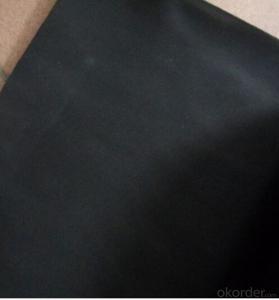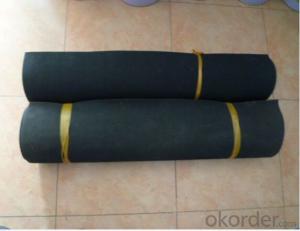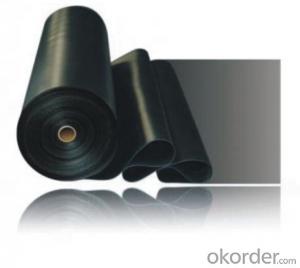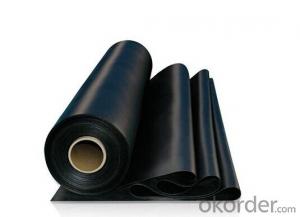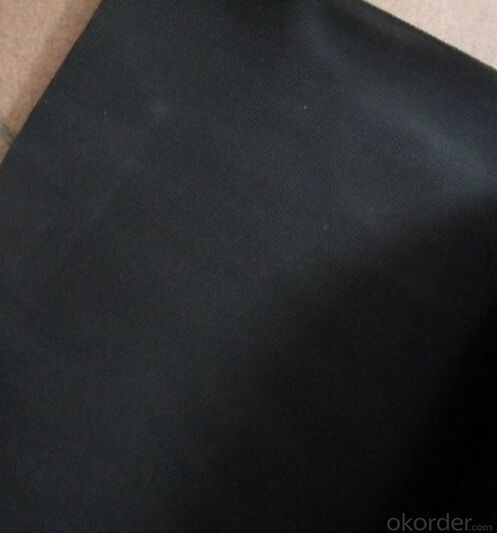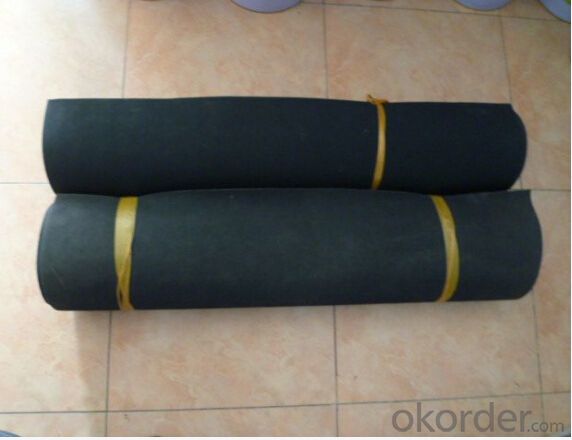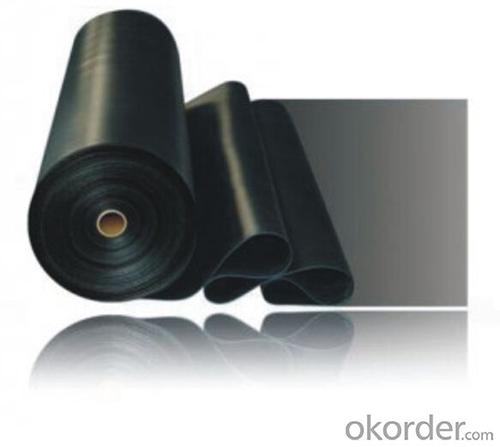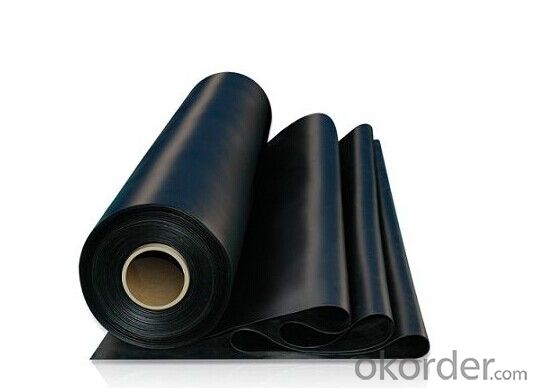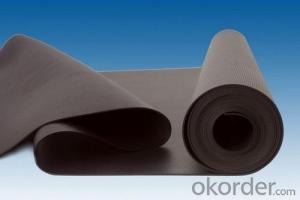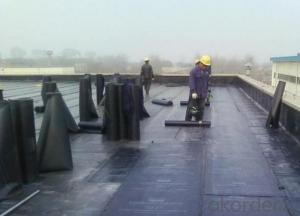EPDM Waterproofing Membrane Factory Price
- Loading Port:
- Qingdao
- Payment Terms:
- TT OR LC
- Min Order Qty:
- 2000 m²
- Supply Capability:
- 100000 m²/month
OKorder Service Pledge
OKorder Financial Service
You Might Also Like
EPDM waterproofing Rubber membrane
1. Introduction of EPDM Waterproofing Membrane:
EPDM Waterproofing Membrane is the modified materials which is widely used at home and abroad in the kinds of roofs, tunnel, basement such sorts of constructions' waterproofing.
They are based upon EPDM rubber with modifier, softener and accelerant assistants added to provide flexibility and stability . Through the precise ingredients, mixing, extrusion, rolling, curing processes to made of modified EPDM Waterproofing material with high strength and high flexibility.
2. Specification of EPDM Waterproofing Membrane:
Type | EPDM Waterproof Membrane | ||
Material | EPDM Rubber | ||
Thickness | 1.2mm | 1.5mm | 2.0mm |
Weight(kg/m2) | 1.54-1.58 | 1.79-1.83 | 2.25-2.29 |
Size | 1.2m(width) * 20m(length)/roll | ||
Type | Vulcanized & Weldable | ||
Pattern | Non-reinforced(homogeneous) | ||
Packing | 24sqm/roll, with plastic bag | ||
Color | Black | ||
Application | Roof, basement, pond, Lake, steel structure roof, swimming pool, underground, tunnel, etc | ||
3. Product Features of EPDM Waterproofing Membrane:
1. Great tensile strength,long-range elasticity and aging resistant.
2. Excellent heat reisistant and can be used under -70°C~~+110°C .
3.Good anti-corrosion, ultraviolet resistant, root penetration resistance
4.Long life use over 50 years and used longer 100 years or more under the condition of buried in the ground.
5.Light and easy to install.
4. Application of EPDM Waterproofing Membrane:
(1) Roofs, Basement, Toilets
(2) Industrial and civil building waterproofing
(3) Geosynthetic liner for swimming pool, channels, irrigation system
(4) Especially suitable for projects with high requirements in durability, anti-corrosion and deformation
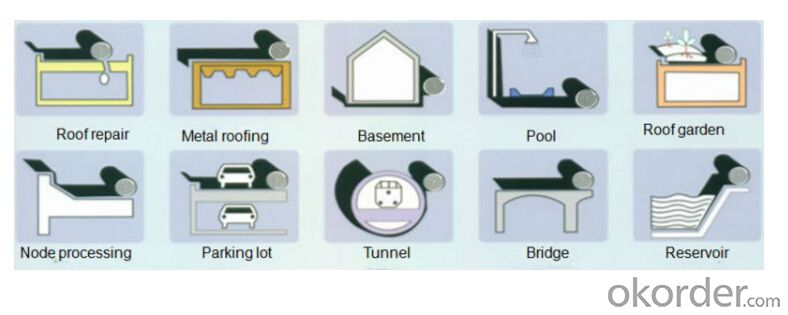
4. Some photos:
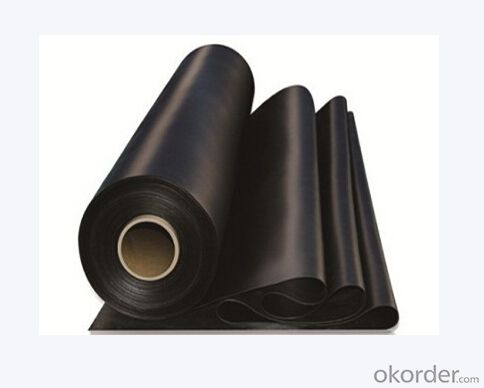
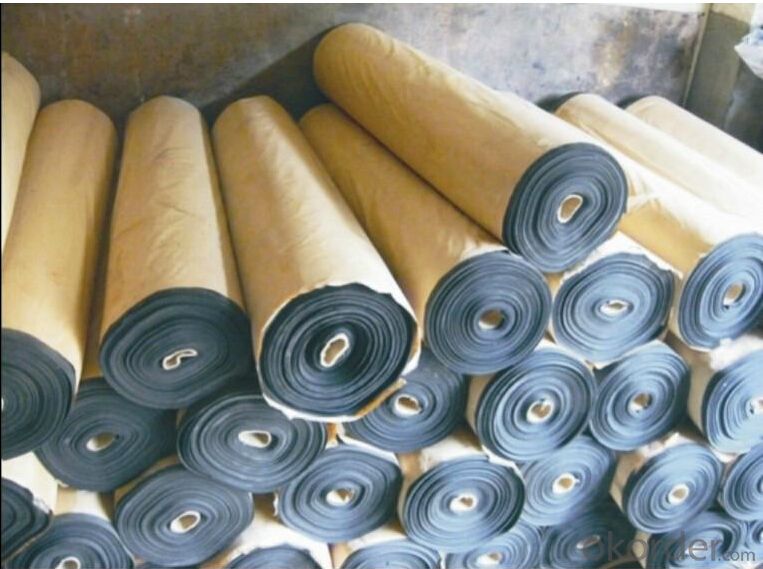
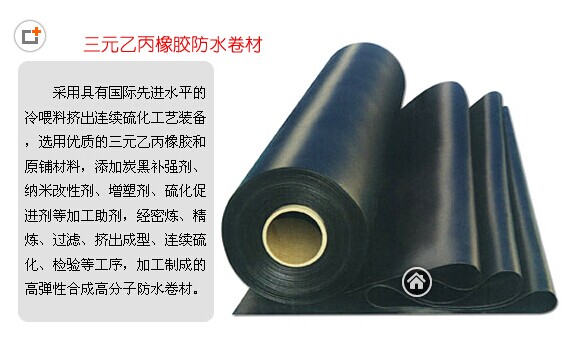
- Q: Can a waterproofing membrane be used for a planter box?
- Yes, a waterproofing membrane can be used for a planter box. A waterproofing membrane is designed to prevent water from penetrating the surface it is applied to, making it an ideal choice for protecting the planter box from moisture damage. By applying a waterproofing membrane to the interior of the planter box, it helps to create a barrier that prevents water from seeping through and potentially causing damage to the wood or material of the planter box. This can be particularly useful in situations where the planter box is constantly exposed to water, such as when used outdoors or for hydroponic gardening. Overall, using a waterproofing membrane for a planter box can help to extend its lifespan and ensure that it remains in good condition for a longer period of time.
- Q: Can a waterproofing membrane be used in conjunction with warranty or insurance policies?
- Typically, a waterproofing membrane can be used alongside warranty or insurance policies. Various waterproofing products and systems come with warranties that offer coverage for a specific duration, typically ranging from 5 to 20 years or even longer. These warranties often guarantee the effectiveness and durability of the waterproofing membrane, and may include provisions for repairs or replacements in the event of any failures or defects. Moreover, insurance policies may also provide coverage for damages caused by water leaks or flooding. By installing a waterproofing membrane, property owners can minimize the risk of water damage and potentially lower their insurance premiums. It is advisable to inquire with your insurance provider to determine if they offer any discounts or incentives for utilizing waterproofing systems. Nevertheless, it is crucial to note that the coverage provided by warranties and insurance policies may vary based on specific terms and conditions. It is recommended that you carefully review the details of the warranty or insurance policy and seek guidance from professionals to ensure that the waterproofing membrane aligns with the requirements and specifications outlined in these agreements.
- Q: Can a waterproofing membrane be used in conjunction with sustainable construction materials?
- Indeed, the use of a waterproofing membrane alongside sustainable construction materials is gaining traction in the construction industry. This is due to the growing emphasis on environmentally friendly and energy-efficient buildings. Waterproofing membranes serve to safeguard sustainable construction materials, such as recycled or low-impact materials, against water damage and moisture infiltration. By forming a barrier, these membranes prevent water from permeating the materials, thereby extending their lifespan and reducing the necessity for repairs or replacements. Furthermore, sustainable construction materials are often engineered to enhance energy efficiency, which can be further augmented through the employment of a waterproofing membrane. By averting water damage, the membrane upholds the structural integrity of the building envelope, curbing potential energy loss from leaks or moisture intrusion. In addition, specific waterproofing membranes are designed with sustainability in mind. For instance, there are eco-friendly membranes fabricated from recycled materials or those that can be recycled at the end of their life cycle. These sustainable membranes minimize the environmental impact associated with their production and disposal. In conclusion, the integration of a waterproofing membrane in conjunction with sustainable construction materials is a wise and conscientious approach to building design. It ensures the long-term durability and performance of the materials, while also contributing to a more sustainable and energy-efficient built environment.
- Q: Can a waterproofing membrane be used on tunnels with architectural features?
- Yes, a waterproofing membrane can be used on tunnels with architectural features. Waterproofing membranes are versatile and can be applied to various types of structures, including tunnels with architectural features. These membranes are designed to create a barrier against water infiltration, protecting the structure from moisture damage. Whether the tunnel has unique architectural features such as curves, arches, or decorative elements, a waterproofing membrane can be customized and applied to ensure complete waterproofing. It is essential to consult with a professional waterproofing contractor who has experience in working with tunnels and architectural features to determine the most suitable membrane system for the specific project requirements.
- Q: Can waterproofing membranes be used on swimming pool decks?
- Yes, waterproofing membranes can be used on swimming pool decks to protect them from water damage and leaks.
- Q: Are waterproofing membranes suitable for stadium structures?
- Waterproofing membranes are well-suited for stadium structures. Stadiums are exposed to different weather conditions, such as rain, snow, and humidity, which can potentially harm the structure if proper waterproofing measures are not taken. By providing a protective layer that prevents water infiltration, waterproofing membranes safeguard the stadium from moisture-related problems like leaks, mold, and corrosion. Water accumulation on large roof areas and expansive seating areas is common in stadium structures, making waterproofing essential. Membranes can be applied on various surfaces, such as concrete, metal, and wood, offering a versatile and effective waterproofing solution for stadiums. Furthermore, waterproofing membranes offer durability and longevity, which is crucial for stadiums that experience heavy usage and constant exposure to the elements. They are designed to withstand thermal expansion and contraction, as well as UV radiation, ensuring long-term protection for the structure. Moreover, architects and engineers can customize waterproofing membranes to meet specific design requirements, seamlessly integrating them into the stadium's overall aesthetic. These membranes come in various colors, textures, and finishes, allowing them to blend with the surrounding materials and enhance the stadium's visual appeal. In conclusion, waterproofing membranes are a reliable and effective solution for protecting stadium structures from water damage. They provide durability, versatility, and customization options, making them suitable for any stadium construction or renovation project.
- Q: Can a waterproofing membrane be used for schools or universities?
- Yes, a waterproofing membrane can definitely be used for schools or universities. These membranes are designed to provide protection against water damage, preventing leaks and moisture intrusion in buildings. By installing a waterproofing membrane, schools and universities can ensure the longevity of their structures, protect valuable assets, and maintain a safe and comfortable environment for students and faculty.
- Q: Can a waterproofing membrane be used on concrete slabs or foundations?
- Yes, a waterproofing membrane can be used on concrete slabs or foundations. Waterproofing membranes are commonly used in construction to prevent water penetration and protect structures from moisture damage. By applying a waterproofing membrane to a concrete slab or foundation, it creates a barrier that prevents water from seeping into the concrete and causing potential issues like cracking, water damage, or mold growth. This membrane is designed to withstand hydrostatic pressure, which is the force exerted by standing water, and it can effectively keep the area dry. It is important to select a suitable waterproofing membrane that is compatible with concrete and the specific conditions of the project. Proper installation and maintenance of the membrane are also crucial for long-term waterproofing effectiveness.
- Q: Can a waterproofing membrane be used for retaining walls?
- A waterproofing membrane is suitable for retaining walls as it helps to prevent water from penetrating and causing damage or structural failure. These membranes, made of materials like rubber, PVC, or bituminous compounds, are installed on the inner side of the retaining wall to create a barrier against water infiltration. In addition to protecting the wall's stability, some membranes also offer resistance to root penetration, UV protection, and flexibility to accommodate movement. However, it is crucial to consider factors such as the type of retaining wall, water pressure, and local climate conditions when selecting the right waterproofing membrane. It is advisable to consult with a professional engineer or contractor to ensure the most suitable waterproofing solution for your specific retaining wall project.
- Q: Can a waterproofing membrane reduce noise transmission?
- Yes, a waterproofing membrane can help reduce noise transmission. Waterproofing membranes are typically made of materials with good sound insulation properties, such as rubber or synthetic polymers. When applied to surfaces, they create a barrier that helps absorb or block sound waves, reducing the amount of noise that can pass through the structure. Additionally, waterproofing membranes can also help seal gaps and cracks in walls or floors, further reducing noise leakage. So, while the primary function of a waterproofing membrane is to prevent water infiltration, it can also have the secondary benefit of reducing noise transmission.
Send your message to us
EPDM Waterproofing Membrane Factory Price
- Loading Port:
- Qingdao
- Payment Terms:
- TT OR LC
- Min Order Qty:
- 2000 m²
- Supply Capability:
- 100000 m²/month
OKorder Service Pledge
OKorder Financial Service
Similar products
Hot products
Hot Searches
Related keywords
